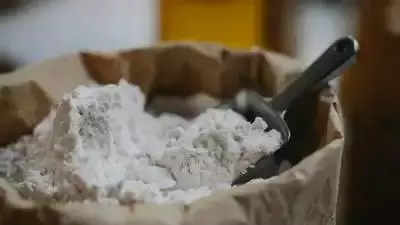Wheat flour is a staple in most households, used for making various dishes, from bread to chapatis. However, the quality and purity of wheat flour are increasingly coming under question, with rising incidents of adulteration. Adulteration refers to the deliberate act of lowering the quality of food products by adding inferior substances. Wheat flour, being a common item, is often adulterated with substances like chalk powder, starch, or even cheaper grains. Consuming adulterated flour can lead to serious health risks. Here are five simple yet effective methods to help you identify if your wheat flour is pure or adulterated.
1. Check for the Colour and Texture
One of the easiest ways to check the purity of wheat flour is by examining its colour and texture. Pure wheat flour typically has a uniform off-white or pale yellowish colour. If the flour appears unnaturally white or has specks of grey, it may be adulterated with substances like chalk powder or bleaching agents.
Additionally, the texture of pure wheat flour is smooth and fine to touch. If the flour feels gritty or coarse, it could indicate the presence of foreign particles or impurities.
How to Perform This Test
Take a small quantity of the wheat flour in your hand and examine its colour and feel its texture. Pure flour should feel soft and smooth. Any grainy or gritty texture could point to adulteration.
2. Water Test for Chalk Powder
A common adulterant in wheat flour is chalk powder. This adulteration is not only harmful but also easy to detect using a simple water test.
How to Perform This Test
Take a transparent glass and fill it with water. Add a teaspoon of wheat flour to the water and stir. Allow it to sit for a few minutes. If the flour is pure, it will mostly settle at the bottom without clouding the water significantly. If the water turns white or cloudy, there is a good chance the flour contains chalk powder or other impurities.
3. Iodine Test for Starch
Another adulterant in wheat flour is excess starch, which is sometimes added to bulk up the flour. This can be detected using iodine, a household item commonly available in first aid kits.
How to Perform This Test
Take a small amount of wheat flour and mix it with a few drops of water to form a paste. Then, add a few drops of iodine solution to the paste. If the paste turns blue-black, it indicates the presence of excessive starch, suggesting that the flour has been adulterated.
4. Ball Test for Presence of Chalk or Soapstone
Chalk or soapstone powder is another adulterant commonly found in low-quality wheat flour. These substances can be identified by the behaviour of the flour when mixed with water.
How to Perform This Test
Take a teaspoon of wheat flour and knead it into a ball using a small amount of water. After forming the ball, rub it gently on a hard surface, like a countertop. If the flour is pure, the ball will hold its shape and won’t leave much residue. However, if the flour contains chalk or soapstone, the ball will easily crumble, and a white residue will be left behind on the surface.
5. Taste Test
Though this method is subjective, the taste of pure wheat flour is fairly distinct. If you notice any off or unusual flavours, it could indicate adulteration. Pure wheat flour should have a neutral taste, while flour contaminated with substances like soapstone or chalk may have a slightly bitter or soapy aftertaste.
How to Perform This Test
Take a pinch of wheat flour and taste it directly. If it tastes off, sour, or has an unpleasant aftertaste, it is best to avoid using the flour, as it may contain harmful adulterants.
The Importance of Pure Wheat Flour
Consuming adulterated wheat flour not only lowers the nutritional value of your meals but also poses significant health risks. Prolonged intake of contaminated flour can lead to digestive problems, reduced immunity, and, in extreme cases, poisoning from chemicals like chalk powder or bleach. By using these simple methods at home, you can ensure that the wheat flour you use is safe and free from harmful substances. Regularly checking your food for purity is essential for maintaining good health and well-being.
Wheat flour adulteration is a common issue that can affect the quality of your meals and your overall health. While adulterated flour may be difficult to identify at first glance, these five easy methods offer practical solutions that can be performed at home. Checking the colour, performing water and iodine tests, and even conducting simple texture and taste checks can help you identify impurities in wheat flour. By doing so, you can ensure that the flour you use is pure, safe, and beneficial for you and your family.
1. Check for the Colour and Texture
One of the easiest ways to check the purity of wheat flour is by examining its colour and texture. Pure wheat flour typically has a uniform off-white or pale yellowish colour. If the flour appears unnaturally white or has specks of grey, it may be adulterated with substances like chalk powder or bleaching agents.
Additionally, the texture of pure wheat flour is smooth and fine to touch. If the flour feels gritty or coarse, it could indicate the presence of foreign particles or impurities.
How to Perform This Test
Take a small quantity of the wheat flour in your hand and examine its colour and feel its texture. Pure flour should feel soft and smooth. Any grainy or gritty texture could point to adulteration.
2. Water Test for Chalk Powder
A common adulterant in wheat flour is chalk powder. This adulteration is not only harmful but also easy to detect using a simple water test.
How to Perform This Test
Take a transparent glass and fill it with water. Add a teaspoon of wheat flour to the water and stir. Allow it to sit for a few minutes. If the flour is pure, it will mostly settle at the bottom without clouding the water significantly. If the water turns white or cloudy, there is a good chance the flour contains chalk powder or other impurities.
3. Iodine Test for Starch
Another adulterant in wheat flour is excess starch, which is sometimes added to bulk up the flour. This can be detected using iodine, a household item commonly available in first aid kits.
How to Perform This Test
Take a small amount of wheat flour and mix it with a few drops of water to form a paste. Then, add a few drops of iodine solution to the paste. If the paste turns blue-black, it indicates the presence of excessive starch, suggesting that the flour has been adulterated.
4. Ball Test for Presence of Chalk or Soapstone
Chalk or soapstone powder is another adulterant commonly found in low-quality wheat flour. These substances can be identified by the behaviour of the flour when mixed with water.
How to Perform This Test
Take a teaspoon of wheat flour and knead it into a ball using a small amount of water. After forming the ball, rub it gently on a hard surface, like a countertop. If the flour is pure, the ball will hold its shape and won’t leave much residue. However, if the flour contains chalk or soapstone, the ball will easily crumble, and a white residue will be left behind on the surface.
5. Taste Test
Though this method is subjective, the taste of pure wheat flour is fairly distinct. If you notice any off or unusual flavours, it could indicate adulteration. Pure wheat flour should have a neutral taste, while flour contaminated with substances like soapstone or chalk may have a slightly bitter or soapy aftertaste.
How to Perform This Test
Take a pinch of wheat flour and taste it directly. If it tastes off, sour, or has an unpleasant aftertaste, it is best to avoid using the flour, as it may contain harmful adulterants.
The Importance of Pure Wheat Flour
Consuming adulterated wheat flour not only lowers the nutritional value of your meals but also poses significant health risks. Prolonged intake of contaminated flour can lead to digestive problems, reduced immunity, and, in extreme cases, poisoning from chemicals like chalk powder or bleach. By using these simple methods at home, you can ensure that the wheat flour you use is safe and free from harmful substances. Regularly checking your food for purity is essential for maintaining good health and well-being.
Wheat flour adulteration is a common issue that can affect the quality of your meals and your overall health. While adulterated flour may be difficult to identify at first glance, these five easy methods offer practical solutions that can be performed at home. Checking the colour, performing water and iodine tests, and even conducting simple texture and taste checks can help you identify impurities in wheat flour. By doing so, you can ensure that the flour you use is pure, safe, and beneficial for you and your family.
You may also like

Megan Thee Stallion receives heartfelt apology from boyfriend Klay Thompson after airport pickup mishap

Trump administration asks Supreme Court to halt order providing full SNAP payments for November

Hurricane Melissa claims at least 75 lives, impacts nearly 5 million people in Caribbean

India urges developed nations to act faster on emissions at COP30, says global carbon budget "rapidly depleting"

NBA's highly anticipated Europe-based league's potential release date revealed







